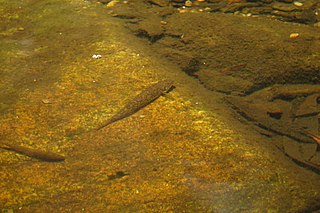Awaous macrorhynchus is a species of goby endemic to Madagascar where it is known from brackish and fresh waters. This species can reach a length of 38 centimetres (15 in) TL.
Awaous is a genus of fish in the family Gobiidae, the gobies. They are native to fresh, marine and brackish waters from Africa to the Americas.
Awaous stamineus, commonly known as ‘O‘opu nakea, is a species of goby native to the Hawaiian Islands. It has been previously considered a synonym of Awaous guamensis but recent work based upon morphological and genetic differences has recognized Hawaiian populations as being distinct. Consequently, Hawaiian Awaous are now recognized as a valid, distinct species.
The Hawaiian freshwater goby, or ‘O‘opu, is a species of goby endemic to Hawaii, where it occurs in mountain streams. Males of this species can reach a standard length of 7 cm (2.8 in), while females only reach 6 cm (2.4 in).

Sicyopterus stimpsoni, commonly known as the Nopoli rockclimbing goby, oopu nopili, or Stimpson's goby, is a species of amphidromous goby endemic to Hawaii. This species can reach a length of 19.8 centimetres (7.8 in) SL.
Awaous guamensis is a species of goby native to the Pacific islands from the Marianas to Vanuatu, New Caledonia and Fiji where it can be found in fresh, brackish and marine waters. Recent work based upon morphological and genetic differences has recognized Hawaiian populations of Awaous as being distinct from Awaous guamensis. Consequently, Hawaiian Awaous are now recognized as a distinct species Awaous stamineus.

Awaous acritosus, the Roman nose goby, is a species of goby that is native to fresh water rivers and streams of Queensland, Australia and the Laloki River drainage of New Guinea.
Awaous grammepomus, the Scribbled goby, is a species of goby native to freshwater streams and rivers and brackish estuaries from Sri Lanka to New Guinea with a report of it occurring in Palau. This species can reach a length of 15 centimetres (5.9 in) SL. It is of minor importance to local commercial fisheries and can also be found in the aquarium trade.

Awaous lateristriga, the West African freshwater goby, is a species of goby found in marine, fresh and brackish waters along the Atlantic coast of Africa from Senegal to the Cunene River, Angola and also from islands in the Gulf of Guinea. This species can reach a length of 26.4 centimetres (10.4 in) TL.

Awaous ocellaris is a species of goby native to fresh, marine and brackish waters of southern Asia from India to the Philippines, and eastern Asia to Japan as well as the islands of Oceania. This species can reach a length of 13 centimetres (5.1 in) TL. It is of minor importance to local commercial fisheries.

Oxyurichthys microlepis, commonly known as the maned goby, is a species of goby native to tropical marine and brackish waters along the coasts of the Indian Ocean from Africa to the western Pacific Ocean where it occurs in estuaries and inshore waters to depths of about 75 metres (246 ft). It occurs in the Mekong Delta and is suspected to use the tidal flow up the river to reach as far inland as Cambodia. This species can reach a length of 13.5 centimetres (5.3 in) TL. It is of minor importance to local commercial fisheries and can also be found in the aquarium trade.

The Gobionellinae are a subfamily of fish which was formerly classified in the family Gobiidae, the gobies, but the 5th Edition of Fishes of the World classifies the subfamily as part of the family Oxudercidae. Members of Gobionellinae mostly inhabit estuarine and freshwater habitats; the main exception is the genus Gnatholepis, which live with corals in marine environments. The subfamily is distributed in tropical and temperate regions around the world with the exception of the northeastern Atlantic Ocean, the Mediterranean Sea, and the Ponto-Caspian region. It includes around 370 species and 55 genera: Wikipedia articles about genera list about 389 species.
Awaous melanocephalus, the largesnout goby, is a species of goby that is native to fresh water rivers and streams of India, Sri Lanka, Ryukyu Islands, China, Taiwan, Vietnam, Thailand, Philippines, Indonesia, Papua New Guinea and Solomon Islands. Some suggestions has been recorded from Fiji islands and Mauritius, but not confirmed yet.
Awaous commersoni, or Commerson's freshwater goby, is a species of goby found on islands in the south-western Indian Ocean.
Awaous litturatus is a species of goby found in the Philippines.

Awaous personatus is a species of goby found in Indonesia.
Awaous pallidus is a species of goby found in Mauritius.
Awaous bustamantei is a species of goby found in Africa.
Awaous fluviatilis is a species of goby found in the Indian Ocean.








